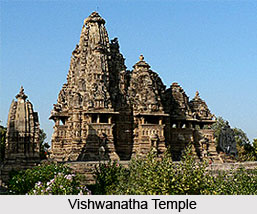 Vishvanatha temple was built by the powerful King Dhangadeva which is some of the exceptional sites of Khajuraho. Built in early 11th century this temple stands gloriously with its sculptures and stone carvings. The temple is well decorated with some exceptional stone sculptures which attract the attention of the tourists from the very entrance. From the entrance till the inner sanctum the temple includes some exceptional sculptures of Lord Shiva and Goddess Parvati. Like other temples this too is well known for its architecture.
Vishvanatha temple was built by the powerful King Dhangadeva which is some of the exceptional sites of Khajuraho. Built in early 11th century this temple stands gloriously with its sculptures and stone carvings. The temple is well decorated with some exceptional stone sculptures which attract the attention of the tourists from the very entrance. From the entrance till the inner sanctum the temple includes some exceptional sculptures of Lord Shiva and Goddess Parvati. Like other temples this too is well known for its architecture.
Vishvanatha temple is often known for the panelling which contains the images of earthly and divine beings and the image of groups of musicians which is sculptured in the panels that run through out the temple. The temple has a number of gates. While the northern gate is decorated withy the statues of Lions, the southern gates are decorated with the statues of the elephants. Vishvanatha temple is one of the exclusive temples which is known for its architecture. Along with beautiful sculptures and curvatures the temple also includes a flair of staircases which begins from the very entrance. These lead the visitors to the main mandapa which in turn leads to the shikhara- the main attraction of the Khajuraho temples. The garbagriha of the temple has the prime shrine of Lord Brahma with three heads along with the shrines of Lord Shiva and Parvati. Besides this the most attractive is the huge structure of Nandi that lay in front of the temple. The six feet high image of nandi is one of the major attractions of the temple for which the tourists often get attracted.
Also the temple has a number of inscriptions that define the history of the temple. It has a long inscription stating that Dhangadeva who installed an emerald linga. The temple was then known as the Marakateshvara, the Lord of the Emerald Linga. This precious linga was already missing in 1864, when Cunningham visited the temple. The architect, according to the inscription, was Sutradhara Chhichchha, who was well versed in the architectural tradition of Vishvakarma. It is also significant that this is the only temple at Khajuraho that has its Nandi-mandapa or pavilion for the bull mount of Shiva intact. A magnificent Nandi sits facing the temple.
Originally the Vishvanatha temple was five-shrined (panchayatana) like the Lakshmana, but now only two survive. It is a sandhara temple with an inner ambulatory. Graceful apsaras decorate the pilasters and the sanctum wall in the interior of the temple. The theme of the apsara with a scorpion can be found on the west wall of the sanctum. Other beautiful figures, arranged in three rows, adorn the exterior walls. The architect of this temple seems to have been the first to place the seven Matrikas, in a peculiar counter circumambulatory manner on the exterior plinth. The architect of the Kandariya Mahadeva later adopted this placement.
Thus with its exclusive architecture and sculptures it is one of the unique temples of Khajuraho that describes the cultural heritage of the temple. With structures of Nandi and Brahma it is one of the exclusive temples that is different from other temples of Khajuraho.











